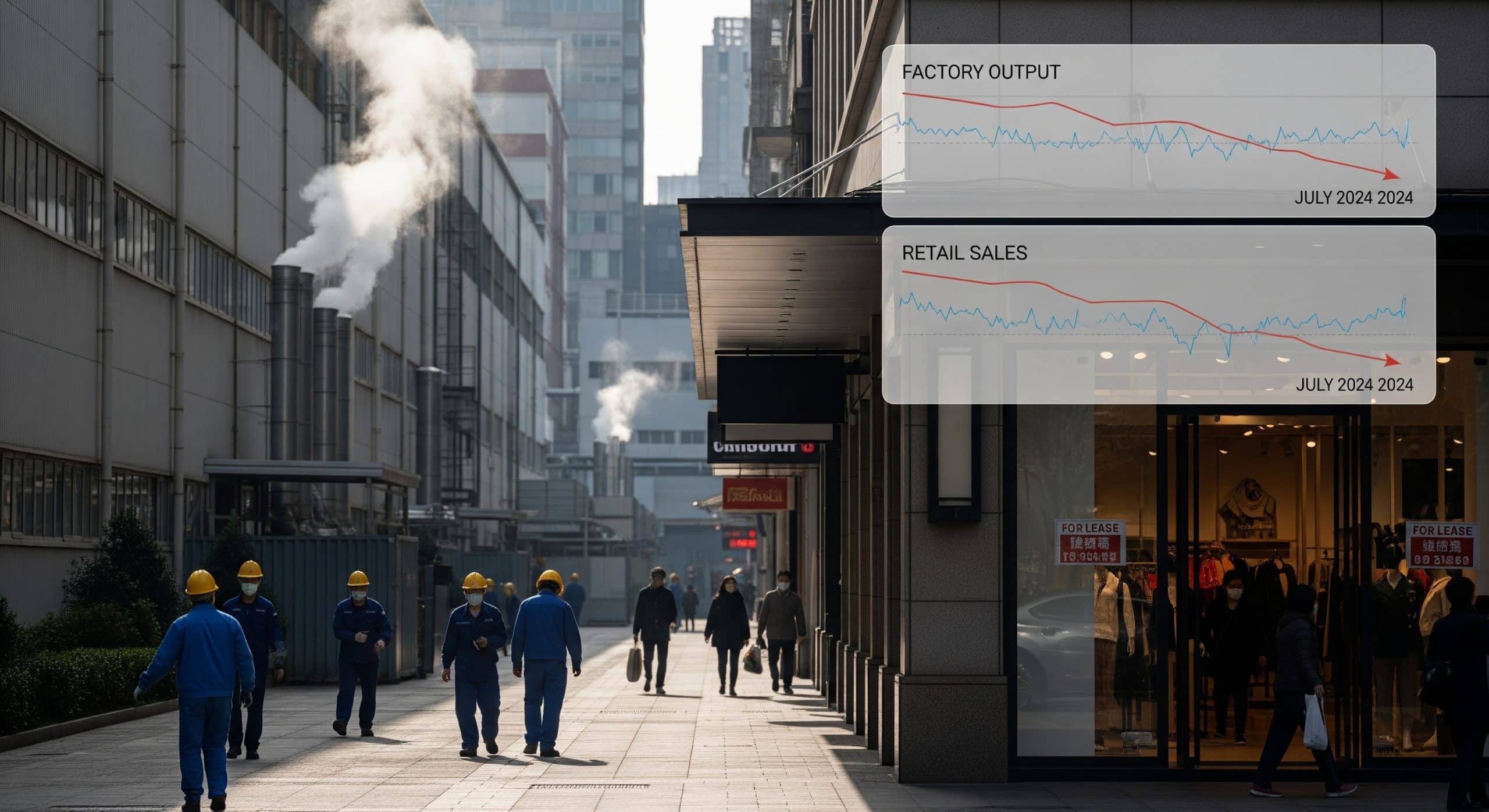The Impact of July’s Factory Output and Retail Sales Slump on China’s Economic Growth
In July, China experienced a significant slip in both factory output and retail sales, signaling potential troubles for the nation’s economic momentum. The figures unveiled by the National Bureau of Statistics indicate a concerning trend. As a leading global economic powerhouse, China’s performance often casts a long shadow throughout the world, and such numbers raise eyebrows across global markets.
Factory output, which reflects manufacturing activity, saw a noticeable dip compared to previous months. Analysts observed that July’s industrial production grew by only 3.7%, marking a notable decline from 4.4% in June. This slowing growth in factory output not only affects domestic economies but also has repercussions for global supply chains reliant on Chinese manufacturing.
Retail sales, another critical indicator of economic health, painted a similar picture. Retail sales growth fell to 2.7% in July, down from a respectable 3.1% in June. This decline underscores a weak consumer sentiment within the country. When consumers spend less, businesses feel the impact, often leading to a ripple effect throughout the economy.
Several factors contribute to this slump. First, rising inflation has left consumers with less disposable income. Households are feeling the pinch, particularly with prices on key goods climbing. Furthermore, ongoing global uncertainties and domestic policies impact confidence levels among consumers and businesses alike. As a result, many may be holding back on spending, anticipating economic instability.
Another crucial element to consider is the manufacturing sector’s struggles with power shortages. This issue has hampered production lines, pushing companies to operate below capacity. The challenges presented by strict energy policies have affected not only factories but also logistics and distribution chains.
Here are some critical aspects to consider regarding the situation:
Global Implications: China plays a pivotal role in the global economy. A slump in its factory output and retail sales can lead to disruptions in international trade and impacts various industries worldwide.
Consumer Confidence: Consumers form the backbone of the economy. Low retail sales suggest that confidence is waning, potentially leading to further reductions in spending.
Manufacturing Strain: With factories struggling to meet demand due to energy shortages, there’s a risk of creating a bottleneck in production that could last for months.
Government Responses: The Chinese government may introduce measures to stimulate growth. This can include monetary policy adjustments or fiscal incentives aimed at boosting consumption.
As we analyze these factors, it’s essential to look at the ripple effects on various sectors. A declining manufacturing output could hurt exports, vital for China’s economic engine. If factories cannot deliver products on time, the country risks losing its competitive edge in the global market, which may influence economic relationships with trading partners.
Moreover, weaker consumer spending could lead to stagnant retail markets. Businesses may face the complex decision of cutting costs, which often results in job losses, creating a negative cycle that further dampens economic activity. With less confidence in the economy, businesses might hesitate to invest in growth or expansion, leading to a potential slowdown in innovation and productivity enhancements.
It’s not just the numbers on the page that matter but what they indicate about consumer behavior and economic health. Without a robust manufacturing base and consumer spending to back it up, China’s economy may struggle to achieve lasting growth.
All eyes will remain on China’s economic policies in the coming months. As the government navigates these challenges, the world will watch to see if steps taken can reverse the downward trend. The impact of these economic indicators stretches beyond China, making them relevant for all engaged in global commerce and trade.
The situation in July could be a wake-up call. Sustained growth relies on the synergy between factory output and consumer sentiment. Without addressing these issues, economic momentum might remain at risk, potentially leading to a more significant downturn. The resilience of China’s economy will ultimately hinge on its ability to adapt and respond to these pressing challenges.
Strategies for Stabilizing Economic Momentum in Face of Falling Manufacturing and Retail Numbers
The recent decline in manufacturing and retail figures has raised concerns about economic stability. Lower outputs from factories and shrinking retail sales can indicate deeper issues in the economy, impacting growth trajectories. It’s crucial for policymakers, businesses, and economists to implement strategies aimed at stabilizing economic momentum in these challenging times.
Understanding the Impact of Falling Numbers
When factory outputs decrease and retail sales slump, it can lead to significant economic repercussions. A reduced manufacturing output means fewer jobs, lower income, and diminished consumer spending, which subsequently affects retail. These interconnected elements create an environment of uncertainty, making it essential to address the issue promptly.
Adaptive Monetary Policy
A flexible monetary policy can play a vital role in stabilizing economic momentum. Central banks should consider:
Lowering Interest Rates: Reducing interest rates can encourage borrowing and spending. When loans are cheaper, individuals and businesses are more likely to invest and purchase goods.
Quantitative Easing: This involves buying government and corporate bonds to inject liquidity into the market. Increased cash flow can stimulate business activities and consumer confidence.
Forward Guidance: Clear communication about future monetary policy can help stabilize expectations. When people know what to expect, they’re more likely to plan their spending.
Encouraging Consumer Spending
Consumer spending is crucial to economic momentum. To encourage this, governments and businesses can:
Stimulus Packages: Direct financial assistance to individuals can boost spending. Citizens with extra income are likely to shop and invest in local businesses.
Tax Breaks: Offering tax relief can encourage consumers to purchase big-ticket items, providing a much-needed boost to the retail sector.
Promotions and Discounts: Retailers can entice customers back into stores with sales and special promotions. These strategies can invigorate buying behavior during a slump.
Supporting Small and Medium Enterprises (SMEs)
Small and medium-sized enterprises are the backbone of the economy. Supporting them is essential, especially during economic downturns. Strategies include:
Access to Funding: Ensuring SMEs have access to loans and grants can help them maintain operations and retain employees.
Business Development Programs: Providing training and resources can help SMEs improve their efficiency and adaptability in tough markets.
Network Building: Encouraging collaboration among SMEs can lead to innovation and shared resources, reducing costs and expanding markets.
Investing in Infrastructure
Investment in infrastructure projects creates jobs and stimulates economic activity. Initiatives can focus on:
Transportation: Upgrading roads, bridges, and public transport enhances logistics for manufacturing and retail, making supply chains more efficient.
Technology: Investing in technology infrastructure can improve productivity. Enhancements in internet access and digital tools allow businesses to operate effectively.
Sustainability Projects: Initiating green energy projects not only helps the environment but also opens up job opportunities in emerging sectors.
Fostering International Trade
Expanding trade agreements can provide access to new markets and increase demand for domestic products. Strategies to enhance trade include:
Diversifying Markets: Reducing reliance on a single market can mitigate risks associated with trade disruptions.
Trade Missions: Organizing missions to promote exports helps businesses build relationships with international partners.
Reducing Trade Barriers: Negotiating tariffs and trade agreements can make it easier for domestic products to compete globally.
Evolving economic landscapes demand proactive measures. With the right strategies, it is possible to stabilize economic momentum, encouraging growth amidst challenges. Adopting a combination of monetary policy adjustments, consumer incentives, support for SMEs, infrastructure investments, and trade facilitation can potentially reverse negative trends in manufacturing and retail sectors. By focusing on these areas, stakeholders can ensure a resilient and thriving economy.
Conclusion
As July’s factory output and retail sales figures reveal a concerning trend, the implications for China’s economic growth are significant. The slumping numbers showcase the challenges facing the manufacturing sector and consumer spending, both critical components of the economy. With industrial production contracting and retail sales failing to meet expectations, it’s clear that immediate action is needed to address these issues.
The path forward requires strategic interventions aimed at stabilizing economic momentum. Policymakers can focus on implementing measures such as fiscal stimulus, targeted investments in infrastructure, and enhancing support for small businesses. By fostering a more favorable environment for innovation and consumer confidence, China can combat the effects of the current downturn. Additionally, prioritizing exports through trade partnerships can help to reinvigorate manufacturing output and restore balance to the economy.
By addressing these economic challenges head-on and utilizing a combination of effective policies, China can work towards revitalizing growth and overcoming the slump in factory output and retail sales. It is paramount for the government to remain agile and responsive to changing market conditions, ensuring that the country’s long-term economic health is not compromised. Engaging with various stakeholders—including industries, consumers, and financial institutions—will be pivotal in rolling out strategies that not only stabilize but potentially reinvigorate economic activity in the coming months. The road may be rocky, but with proactive measures, China can navigate through these tumultuous times and emerge stronger on the other side.
Comparison, examination, and analysis between investment houses
Leave your details, and an expert from our team will get back to you as soon as possible
* This article, in whole or in part, does not contain any promise of investment returns, nor does it constitute professional advice to make investments in any particular field.
To read more about the full disclaimer, click here- Articles
- •
- 18 Min Read
- •
- ago 5 minutes
 TENCENT’S EARNINGS BEAT SPARKS PRICE TARGETS SHOWING 16% GAIN
TENCENT’S EARNINGS BEAT SPARKS PRICE TARGETS SHOWING 16% GAIN
The Implications of Tencent’s Earnings Beat on Market Price Targets and Potential 16% Gains The remarkable performance of Tencent in
- ago 5 minutes
- •
- 18 Min Read
The Implications of Tencent’s Earnings Beat on Market Price Targets and Potential 16% Gains The remarkable performance of Tencent in
- Articles
- •
- 18 Min Read
- •
- ago 41 minutes
 DATA CENTERS NEED OWN POWER SUPPLY, US GRID WATCHDOG SAYS
DATA CENTERS NEED OWN POWER SUPPLY, US GRID WATCHDOG SAYS
The Importance of Dedicated Power Supplies for Data Centers: Insights from the US Grid Watchdog In recent discussions, the U.S.
- ago 41 minutes
- •
- 18 Min Read
The Importance of Dedicated Power Supplies for Data Centers: Insights from the US Grid Watchdog In recent discussions, the U.S.
- Articles
- •
- 7 Min Read
- •
- ago 2 hours
 U.S. Economic Outlook: Slowing Growth, Cooling Inflation, and a Persistent Fiscal Deficit
U.S. Economic Outlook: Slowing Growth, Cooling Inflation, and a Persistent Fiscal Deficit
U.S. Economic Outlook: Slowing Growth, Cooling Inflation, and a Persistent Fiscal Deficit The latest U.S. economic forecast paints a complex
- ago 2 hours
- •
- 7 Min Read
U.S. Economic Outlook: Slowing Growth, Cooling Inflation, and a Persistent Fiscal Deficit The latest U.S. economic forecast paints a complex
- Articles
- •
- 6 Min Read
- •
- ago 3 hours
 A Surge in U.S. Business Applications: Why Entrepreneurship Is Rising Despite Economic Headwinds
A Surge in U.S. Business Applications: Why Entrepreneurship Is Rising Despite Economic Headwinds
A Surge in U.S. Business Applications: Why Entrepreneurship Is Rising Despite Economic Headwinds At a time when economic indicators in
- ago 3 hours
- •
- 6 Min Read
A Surge in U.S. Business Applications: Why Entrepreneurship Is Rising Despite Economic Headwinds At a time when economic indicators in












